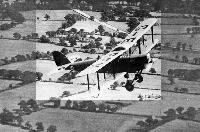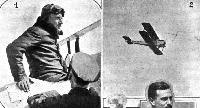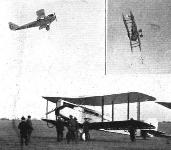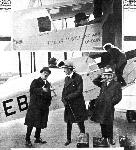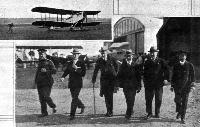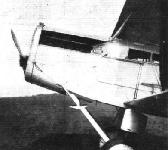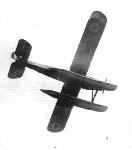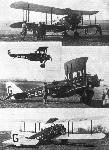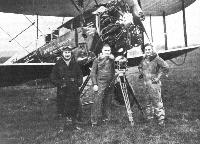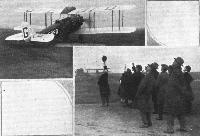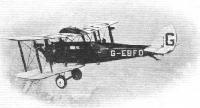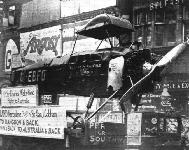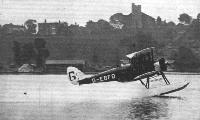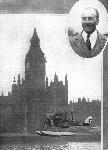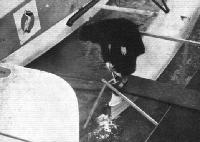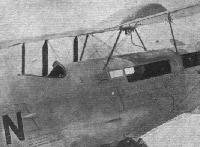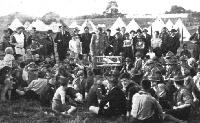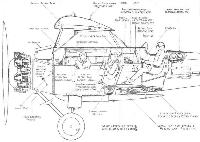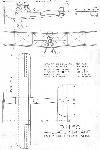
Описание
Страна : Великобритания
Год : 1923
Легкий пассажирский самолет с одним пилотом
de Havilland DH.50
В 1922 году стало ясно, что оставшиеся с военных времен DH.9C более нельзя эксплуатировать из-за износа. Де Хэвилленд спроектировал замену - DH.50. Аэроплан вмещал четырех пассажиров в закрытой кабине между крыльями, пилот размещался за этим салоном в открытой кабине. Мотор Siddeley Puma остался от DH.9C. В итоге получился надежный и экономичный легкий пассажирский аэроплан.
DH.50 впервые взлетел 3 августа 1923 года. Четыре дня спустя под управлением пилота Алана Кобхэма он выиграл первый приз в испытаниях на надежность, которые проводились между датским Копенгагеном и шведским Гётеборгом с 7 по 12 августа. Кобхэм совершил на прототипе несколько дальних перелетов, затем он пересел на второй самолет, оснащенный звездообразным мотором Armstrong Siddeley Jaguar мощностью 385 л. с. (287 кВт), названный DH.50J, и с 16 ноября 1925 года до 17 февраля 1926 года совершил 25-й 749-километровый перелет из Кройдона до Кейптауна. Позднее в 1926 году он выполнил исследовательский перелет в Австралию и обратно, для чего колесное шасси было заменено на поплавковое.
Фирма "de Havilland" построила 16 серийных DH.50. В Австралии фирма QANTAS выпустила по лицензии четыре самолета DH.50A и три DH.50J; фирма "West Australian Airways" собрала три машины DH.50A; "Larkin Aircraft Supply Company" изготовила один DH.50A. В Европе бельгийская фирма SABCA из Брюсселя также по лицензии собрала три DH.50A для Бельгийского Конго. Чешская фирма "Aero" сделала семь самолетов.
Из самолетов, построенных фирмой "de Havilland", в Британии осталось только четыре, две из них принадлежали авиакомпании "Imperial Airways". Один аэроплан закупило правительство Чехословакии, 11 машин попали в Австралию и одна в Новую Зеландию. Дольше всех прослужил 15-й серийный самолет британской сборки, поставленный в 1928 году австралийской инспекции гражданской авиации. В 1942 году его разбомбили японцы во время налета на Новую Гвинею.
ТАКТИКО-ТЕХНИЧЕСКИЕ ХАРАКТЕРИСТИКИ
de Havilland DH.50
Тип: легкий пассажирский самолет с одним пилотом
Силовая установка: рядный поршневой двигатель Siddeley Puma мощностью 230 л. с. (112 кВт)
Летные характеристики: максимальная скорость 180 км/ч на уровне моря; крейсерская скорость 153 км/ч на оптимальной высоте; начальная скороподъемность 184 м/мин; практический потолок 4450 м; дальность полета 612 км
Масса: пустого самолета 1022 кг; максимальная взлетная 1769 кг
Размеры: размах крыльев 13,03 м; длина 9,07 м; высота 3,35 м; площадь крыльев 40,32 м'
Полезная нагрузка: до четырех пассажиров в закрытой кабине.
Описание:
- de Havilland DH.50
- Flight, August 1923
A NEW DE HAVILLAND COMMERCIAL AEROPLANE - Flight, May 1924
THE NEW D.H. AUTOMATIC CAMBER GEAR
Фотографии
-
История Авиации 23 / С.Корж - Коммерческая авиация /Ретроспектива/ (9)
Регистрационный номер: G-EBFO [45] D.H.50J Алана Кобхэма в Порт Дарвине (северное побережье Австралии). Репродукция с открытки того времени.
-
Flight 1923-08 / Flight
Регистрационный номер: G-EBFN [9] The D.H. 50 is a commercial aeroplane carrying four passengers, although the engine is a Siddeley "Puma" of 230 h.p. only. The cruising speed is about 100 m.p.h.
-
Aeroplane Monthly 1974-02 / P.Moss - Wings for the Empire (2)
Регистрационный номер: G-EBKZ G-EBKZ, a D.H.50A used by I.A.L. for taxi work from 1924.
-
Jane's All the World Aircraft 1980 / Encyclopedia of Aviation - Aircraft A-Z - v3
de Havilland D.H.50.
-
Aeroplane Monthly 1988-01 / J.Stroud - Wings of Peace
Регистрационный номер: G-EBFN [9] The prototype D.H.50, G-EBFN. It made its first flight on July 30,1923, from Stag Lane with Hubert Broad at the controls.
-
Aeroplane Monthly 1982-05 / P.Capon - Stag Lane /Capon's Corner/
Регистрационный номер: G-EBFN [9] The D.H.50 prototype, G-EBFN, photographed at Stag Lane in 1925. Powered by a 230 h.p. Siddeley Puma, the D.H. 50 carried four passengers. Seen in the colours of Northern Air Lines Ltd, this D.H.50 was sold in Australia as G-AUEY in February 1926.
-
Aeroplane Monthly 1988-01 / J.Stroud - Wings of Peace
Регистрационный номер: G-EBFO [45] FLYING TO PRAGUE: The D.H.50 is seen actually starting on its splendid flight.
The second D.H.50, G-EBFO, was fitted with full-span automatic flaps. -
Flight 1924-09 / Flight
Регистрационный номер: G-EBFN [9] На de Havilland DH.50 ставили самые разные моторы, включая ADC Nimbus, Bristol Jupiter IV, Jupiter VI, Jupiter XI и Pratt & Whitney Wasp С. Чехи оснащали эти самолеты моторами Walter W-4.
The D.H.50 biplane, 230 h.p. Siddeley "Puma": It •was on a similar machine to this, G-EBFP, that Alan Cobham made his splendid flight to Tangier and back. -
Flight 1924-08 / Flight
Регистрационный номер: G-EBFN [9] FIRST IN THE KING'S CUP RACE: 1. Mr. A. J . Cobham getting out of his D.H.50 (Siddeley "Puma") after winning the race. 2, Cobham, crossing the finishing line.
-
Flight 1923-09 / Flight
A D.H.50 AT GOTHENBURG: Mr. Cobham getting out of his cockpit immediately after winning the competition
-
Flight 1925-03 / Flight
THE END OF A 17,000-MILE FLIGHT: The D.H.50 arriving at Croydon Aerodrome.
-
Flight 1924-05 / Flight
Регистрационный номер: G-EBFO [45] The D.H.50 Landing at about 40 m.p.h. Air Speed: The flaps are right down, and it should be noted that although the machine is very near its stalling angle the tail is well up.
-
Aeroplane Monthly 1990-08 / P.Kucera - Czech fifties (1)
Регистрационный номер: G-EBFO [45] G-EBFO, the second de Havilland-built D.H.50, pictured during its visit to Prague on May 30, 1924 with Lord Thomson aboard. Note the flaps on the upper and lower wings.
-
Aeroplane Monthly 1985-11 / H.Morris - The Barnstormer's Apprentice (1)
Регистрационный номер: G-EBQI [3] Northern Air Lines' D.H.50A G-EBQI was built in 1927. Powered by a 230 h.p. Siddeley Puma, the aircraft was painted blue and silver. This photograph was taken before its acquisition by NAL.
-
Aeroplane Monthly 1988-01 / J.Stroud - Wings of Peace
Регистрационный номер: G-EBQI [3] D.H.50A G-EBQI when in service with Air Taxis at Stag Lane. It later flew with Northern Air Transport and the Brooklands School of Flying.
-
Aeroplane Monthly 1985-11 / H.Morris - The Barnstormer's Apprentice (1)
Регистрационный номер: G-EBQI [3] The Northern Air Lines Puma-engined D.H.50A G-EBQI at Barton in 1931.
-
Flight 1928-05 / Flight
DE HAVILLANDS IN AUSTRALIA: A "Nimbus"-engined D.H.50A, assembled by De Havilland Aircraft Pty., Melbourne.
-
Air Pictorial 1956-11 / Photos by request
Регистрационный номер: VH-UAB [3] NO-NAME DE HAVILLAND D.H.50. Sir Alan Cobham used a 385-h .p. Jaguar (radial) powered D.H .50J (G-EBFO) for his epic England - South Africa survey flight. This photograph illustrates the unique World War II 230-h.p. A.D.C. Nimbus-powered VH-UAB (c/ n. 106), built at Stag Lane in 1924. Before R.A .A.F. impressment as A.10-I it was G-AUAB, then VH-AUB. Four passengers plus pilot (in rear cockpit) could be carried.
-
Aeroplane Monthly 1988-01 / J.Stroud - Wings of Peace
Регистрационный номер: VH-UER The fifth D.H.50, as VH-UER with the Flying Doctor Service.
-
Flight 1926-04 / Flight
"QUANTAS": A D.H. 50 employed for air mail and passenger service by the Queensland and Northern Territory Aerial Services, Ltd., between Charleville and Camooweal, Queensland. Our illustration shows mail and passengers on their arrival at Longreach from Charleville.
-
История Авиации 23 / С.Корж - Коммерческая авиация /Ретроспектива/ (9)
Регистрационный номер: VH-UFA Во второй половине 1920-х гг. под эгидой QANTAS была создана австралийская служба авиационной медицинской помощи, первыми самолетами которой стали D.H.50.
-
Aeroplane Monthly 1978-12 / Personal album
Регистрационный номер: VH-UQX De Havilland D.H.50 VH-UQX, seen at Watut, New Guinea, in 1937 with Nev Bruckhauser in the cockpit, was powered by a Bristol Jupiter radial. The roof of the passenger cabin forward of the cockpit is opened for access.
-
Aeroplane Monthly 1990-08 / P.Kucera - Czech fifties (1)
Регистрационный номер: L-BAHA [2] The first Aero-built D.H.50A at Prague-Kbely state civil aerodrome.
-
Aeroplane Monthly 1990-08 / P.Kucera - Czech fifties (1)
Регистрационный номер: L-BAHC [2] Two views of L-BAHC taken during pre-flight checks, showing detail of struttery and bracing wires.
-
Aeroplane Monthly 1990-08 / P.Kucera - Czech fifties (1)
Регистрационный номер: L-BAHC [2] L-BAHC on one of its inaugural flights during the 1928 season. The CSA aeroplanes wore the dark blue/silver livery of the day.
-
Aeroplane Monthly 1990-09 / P.Kucera - Czech fifties (2)
Регистрационный номер: L-BAHD [5] The fourth Aero-built D.H.50, L-BAHD, photographed after September 1927.
-
Aeroplane Monthly 1990-08 / P.Kucera - Czech fifties (1)
Регистрационный номер: L-BAHD [5] L-BAHD being manhandled. Note the non-standard wheels with square cross-section tyres, possibly taken from a Farman Goliath, an example of which can be seen in the background.
Другие самолёты на фотографии: Farman F.60 Goliath / F.169 - Франция - 1918
-
Aeroplane Monthly 1977-01 / G.Endres - Czechoslovakian Air Transport since 1920 (1)
Регистрационный номер: L-BAHD [5] De Havilland D.H.50 L-BAHD was one of several licence-built at the Aero factory and operated by the company until taken over by CSA in 1927.
-
Aeroplane Monthly 1990-08 / P.Kucera - Czech fifties (1)
Регистрационный номер: L-BAHD [5] L-BAHD photographed during refuelling at Prague circa 1926-27.
-
Aeroplane Monthly 1990-09 / P.Kucera - Czech fifties (2)
Регистрационный номер: L-BAHE [3] Factory-fresh fifth Czech-built D.H.50 L-BAHE photographed near the Aero hangar at Kbely airport. Note the larger-diameter wheels of this licence-built D.H.50 in comparison with its British counterpart.
-
Aeroplane Monthly 1990-09 / P.Kucera - Czech fifties (2)
Регистрационный номер: L-BAHE [3] The fifth Aero D.H.50A L-BAHE in company with Aero A-14 L-BARM, which operated the first CSA routes.
Другие самолёты на фотографии: Aero Ae.01 / A.14 - Чехословакия - 1919
-
Aeroplane Monthly 1990-05 / Personal album. Civil
Регистрационный номер: L-BAHG [2] D.H.50 L-BAHG experimentally fitted with larger, uncovered wheels of squared cross section and new Hedderheimer Kupferwerke metal propeller under test.
De Havilland D.H.50 L-BAHG, later OK-AHG, was one of seven licence-built '50s produced by Aero Tovarno Letadel at Vysocany, Prague in 1925-26. All Czech-built 50s were powered by the 240 h.p. Walter W-4 inline engine. These licence-built de Havilland aircraft were registered L-BAHA to L-BAHG and were later re-registered OK-AHA to OK-AHG when the current Czech registration sequence was introduced. -
Aeroplane Monthly 1990-09 / P.Kucera - Czech fifties (2)
Регистрационный номер: L-BAHG [2] L-BAHG prepared for its passengers. Standing at right is State Civil Airport director B.Trnka. Later registered OK-AHG, this aircraft survived until April 1936.
-
Aeroplane Monthly 1990-08 / P.Kucera - Czech fifties (1)
Регистрационный номер: L-BALG [5] L-BALG seen with Walter W-IV engine and exhaust pipe below the starboard wing and alongside the fuselage.
-
Aeroplane Monthly 1990-08 / P.Kucera - Czech fifties (1)
Регистрационный номер: L-BALG [5] L-BALG, formerly G-EBKJ, photographed near Brandys, north of Prague.
D.H.50 L-BALG was built by the de Havilland company and first registered as G-EBKJ in December 1924. In the following month it was sold to the Czech government as L-BALG, later becoming OK-ALG. -
Aeroplane Monthly 1990-08 / P.Kucera - Czech fifties (1)
Регистрационный номер: L-BALG [5] Another air-to-air view of L-BALG near Prague.
-
Aeroplane Monthly 1990-08 / P.Kucera - Czech fifties (1)
Регистрационный номер: L-BALG [5] The Walter-engined L-BALG with dark blue fuselage of a later period. Note the exhaust pipe below the fuselage.
-
Aeroplane Monthly 1990-09 / P.Kucera - Czech fifties (2)
Регистрационный номер: OH-AHC The third Aero-built D.H.50A as OH-AHC, formerly L-BAHC, in later use as a private mount for Julius Arigi - note the inscription on the engine cowling.
-
Aeroplane Monthly 1990-09 / P.Kucera - Czech fifties (2)
A good detail view of a brand new Aero-built D.H.50A, showing the high standard of production work.
-
Air-Britain Archive 1980-01
Регистрационный номер: O-BAHX The third SABCA-built D.H.50 for Sabena. The aircraft in the air is a Farman Goliath.
This DH.50A O-BAHX was built by SABCA and ended its days in the Congo.Другие самолёты на фотографии: Farman F.60 Goliath / F.169 - Франция - 1918
-
Flight 1924-11 / Flight
THE FLIGHT TO INDIA: On November 20 Air Vice-Marshal Sir Sefton Brancker, Director of Civil Aviation, started on his flight to India on a D.H.50 biplane (Siddeley "Puma") piloted by Alan Cobham. The accompanying photograph shows the "50" being filled with "B.P." fuel prior to the departure from Stag Lane Aerodrome. Incidentally, "B.P." originates from the Persian Oil Fields, one of the countries to be traversed in the course' of the flight, so here, perhaps, is a modern version of "taking coals to Newcastle."
-
Aeroplane Monthly 1990-08 / P.Kucera - Czech fifties (1)
Регистрационный номер: G-EBFO [45] G-EBFO photographed at Prague-Kbely aerodrome on its way to the Far East in early 1925.
-
Air Enthusiast 1999-07 / J.Grant - Anti-clockwise
Регистрационный номер: G-AUAB DH.50A G-AUAB being refuelled at Herne Hill airstrip, WA. This site is now a vineyard.
-
Flight 1926-08 / Flight
Регистрационный номер: L-BALG [5] TWO DE HAVILLANDS: Capt. Broad flying Mrs. Eliott-Lynn's "Moth" above the Czechoslovak D.H.50 and, inset, doing one of his large-diameter slow loops.
Другие самолёты на фотографии: De Havilland Moth / D.H.60 - Великобритания - 1925
-
Aeroplane Monthly 1999-12 / C.Cruddas - Airship to India: Dream & disaster /Civilian trailblazing/
Регистрационный номер: G-EBFO [45] Carpathian villagers assist in getting the D.H.50 to firmer ground.
-
Flight 1928-11 / Flight
FLYING IN CENTRAL AUSTRALIA: The D.H.50 (right) and ANEC III passenger machines at Hermannsburg, Central Australia, after flying 1,300 miles from Melbourne. The pilots were Capt. H. J. Larkin and Capt. F. Neale.
Другие самолёты на фотографии: ANEC III - Великобритания - 1926
-
Flight 1927-03 / Flight
AUSTRALIAN AERIAL SERVICES (LARKIN): Snapshot from a correspondent showing some of the flying-stock of this air transport company, which operates the Adelaide-Cootamundra, Broken Hill-Mildura, and Melbourne-Hay services. A D.H.50 (Siddeley "Puma") on the left and one of the three A.N.E.C.III (Rolls-Royce) six-seaters.
Другие самолёты на фотографии: ANEC III - Великобритания - 1926
-
История Авиации 23 / С.Корж - Коммерческая авиация /Ретроспектива/ (9)
Мистер Кеннеди собственной персоной. Снимок сделан, очевидно, гораздо позднее 1922г., так как на заднем плане явно не "Армстронг Уитворт" F.K.8, а, скорее всего, D.H.50. Последние появились у QANTAS во второй половине 20-х годов.
-
Flight 1923-09 / Flight
THE D.H.50 AT GOTHENBURG: On the left, Mr. Alan J. Cobham on arrival, with his two passengers, Admiral Mark Kerr (centre) and Mr. C. C. Walker, director of the De Havilland Company. On the right, Cobham with some Swedish friends. On Cobham's right is Dr. Malmer, who was responsible for the drawing up of the rules governing the competitions.
-
Flight 1928-05 / Flight
D.H.50A's CARRY DISTINGUISHED AUSTRALIAN PASSENGERS: On the left, His Excellency Lord Stonehaven and Capt. Davidson, prior to leaving on their flight to Tatura in the "Wattle Bird." On the right, the Prime Minister and Mrs. Bruce emplaning in the "Lyre Bird," for a flight to Adelaide.
-
Flight 1924-06 / Flight
FLYING TO PRAGUE: On Friday, May 30 Lord Thomson, Secretary of State for Air, General Sir Sefton Brancker, and Mr. Frank Hodges made the flight from London to Prague in a D.H. 50 (240 Siddeley-Puma), Piloted by Captain Broad.Leaving Croydon at 7.30 a.m., the party arrived on the Kbely aerodrome at Prague at 4.40 p.m. Mr. Hodges was on his way to Vienna, while Lord Thomson and General Sir Sefton Brancker were attending the opening by Professor Masaryk, President of the Czechoslovak Republic, of the Third International Aero Exhibition in Prague. Our photograph shows the three air travellers in merry mood a moment before the departure. Above the luggage is being loaded on board.
-
Flight 1925-03 / Flight
Регистрационный номер: G-EBFO [45] THE END OF A 17,000-MILE FLIGHT: The three happy travellers, from right to left, Gen. Sir Sefton Brancker, Director of Civil Aviation, Mr. Elliott, Engineer, and Mr. Cobham, Pilot.
-
Aeroplane Monthly 1999-12 / C.Cruddas - Airship to India: Dream & disaster /Civilian trailblazing/
Регистрационный номер: G-EBFO [45] Cobham (left), engineer Arthur Elliott and Sir Sefton Brancker (right) prepare to leave Stag Lane.
-
Aeroplane Monthly 1999-12 / C.Cruddas - Airship to India: Dream & disaster /Civilian trailblazing/
Регистрационный номер: G-EBFO [45] During the homeward journey, Cobham was called upon to make several diversionary state visits in India. Seen here with the Maharajah of Datia (centre), the official group provides an interesting variety of sartorial styles.
-
Flight 1925-03 / Flight
At Calcutta: Lord and Lady Lytton and their daughter, Lady Hermonia, discussing their trip in the D.H.50 with General Sir Sefton Brancker and Mr. Cobham.
-
Flight 1933-07 / Flight
A PATIENT BEING PLACED IN THE A.I.M. AMBULANCE PLANE: A striking contrast to the Camel ambulance transport, used in the early days.
-
Aeroplane Monthly 1999-12 / C.Cruddas - Airship to India: Dream & disaster /Civilian trailblazing/
Регистрационный номер: G-EBFO [45] Alan Cobham had to rely on the RAF's repair skills and spares supplies at several locations.
-
Flight 1926-08 / Flight
VISITORS FROM CZECHOSLOVAKIA: During the Orly meeting a D.H.50 built in Prague under licence, arrived with distinguished passengers. This group, taken immediately after the arrival of the machine, includes, from left to right: Pavel Benes, Avia, chief designer; Dr. Lhota, amateur pilot and president of the Czechoslovak Pilots' Association; Mrs. Lhota; M. Srba, member of the Czechoslovak Diet; Maj. Krysner, director of Czechoslovak Railways; Capt. Josef Jira, Ing. Stocis, of the Ministry of Public Works; M. Brebenec, pilot of the D.H.50; and M. Milos Bondy, managing director of the Avia Co.
-
Flight 1924-06 / Flight
BRITAIN'S AIR MINISTER AT PRAGUE: Our photograph shows Lord Thomson with several notabilities who met him on his arrival at the Kbely aerodrome. Inset shows the D.H.50 landing on the Prague aerodrome, carrying Lord Thomson, General Sir Sefton Brancker, and Mr. Frank Hodges. The flight from Croydon to Prague was accomplished in a little under nine hours.
-
Flight 1925-03 / Flight
Регистрационный номер: G-EBFO [45] THE END OF A 17,000-MILE FLIGHT: The D.H.50 is seen surrounded by interested spectators
-
Flight 1925-03 / Flight
Регистрационный номер: G-EBFO [45] Native interest in the D.H.50 at Jalpaiguri.
-
Aeroplane Monthly 1999-12 / C.Cruddas - Airship to India: Dream & disaster /Civilian trailblazing/
Регистрационный номер: G-EBFO [45] Not the kind of jumbos seen at today's airports! At Jalpaiguri in India, elephants help Gurkha troops to safeguard the aircraft.
-
Flight 1925-03 / Flight
Регистрационный номер: G-EBFO [45] At Jalpaiguri the ground was cleared by elephants, here seen standing guard over the D.H.50.
-
Flight 1925-03 / Flight
OFFICIAL WELCOME TO THE VOYAGERS: Maj. J. W. Hills and Mr. Hubert Scott-Paine at Croydon, where, on behalf of the Board of Imperial Airways, they met Gen. Sir Sefton Brancker and Mr. Cobham.
-
Flight 1925-03 / Flight
The End of a Perfect Trip: Gen. Sir Sefton Brancker alighting from the D.H.50, while Mr. Elliott stands by on the wing, and Mr. Cobham greets his many friends.
-
Flight 1925-01 / Flight
DE HAVILLANDS IN AUSTRALIA: Our photographs were taken on the occasion of a flight from Winton to Longreach and back, when the Federal Prime Minister, Mr. Bruce, Mrs. Bruce and a party were the passengers. Above are seen the two machines at Longreach aerodrome. On the left the Prime Minister and Mrs. Bruce are seen conversing with Mr. Fysh, while on the right the D.H.50 is seen taking off from Winton. Note the flat and apparently unlimited aerodrome.
-
Aeroplane Monthly 1999-12 / C.Cruddas - Airship to India: Dream & disaster /Civilian trailblazing/
Регистрационный номер: G-EBFO [45] The touchdown back at Croydon on March 17, 1925, at the end of the return flight from India.
-
Flight 1927-02 / Flight
A D.H.50 FOR NEW ZEALAND: This machine has been ordered for survey work, the cabin being specially arranged for the taking of photographs. Our picture shows the 50 on a test flight, piloted by Captain Broad, shortly before its despatch to the Antipodes. In the background is seen a "Moth," piloted by Capt. Geoffrey de Havilland himself.
Другие самолёты на фотографии: De Havilland Moth / D.H.60 - Великобритания - 1925
-
Flight 1927-10 / Flight
THE RETURN OF THE SCHNEIDER TEAM: The Armstrong-Whitworth "Argosy" of Imperial Airways, Ltd., arrives at Croydon aerodrome, escorted by six Gloster "Grebes" and a de Havilland 50. Considering the extremely gusty wind, the "Grebes" kept excellent formation.
Другие самолёты на фотографии: Armstrong Whitworth Argosy - Великобритания - 1926Gloster Grebe - Великобритания - 1923
-
Flight 1925-03 / Flight
At Calcutta: Government House, Calcutta, from the de Havilland 50.
-
Flight 1925-03 / Flight
Rangoon as seen from the D.H.50: The pagoda with the golden roof may be seen in the distance.
-
Flight 1925-03 / Flight
Vari-coloured rock formation on Persian Gulf.
-
Flight 1925-03 / Flight
Some of the country on the Persian Gulf does not look very inviting for a forced landing.
-
Flight 1926-08 / Flight
An Anglo-Czech Alliance: The 230 h.p. Walter engine in the D.H.50
-
Flight 1926-04 / Flight
LORD STONEHAVEN'S D.H.50: Side View.
-
Flight 1926-04 / Flight
Three-quarter front view of the D.H.50 fitted with floats built by Short Brothers, a portion of whose works may be seen in the background.
-
Flight 1926-04 / Flight
D.H.50 AS A SEAPLANE: This front view shows the clean lines of the machine.
-
Aeroplane Monthly 1988-01 / J.Stroud - Wings of Peace
The D.H.50A for the Governor-General of Australia taking off from the Medway at Rochester in March 1926.
-
Flight 1926-04 / Flight
CLEAN RUNNING: Two views of the D.H.50, fitted with floats, which has been built for Lord Stonehaven, Governor-General of Australia. The absence of spray is most noticeable, and the machine appears to have no tendency to porpoise.
-
Aeroplane Monthly 1988-01 / J.Stroud - Wings of Peace
Регистрационный номер: A8-1 D.H.50A floatplane A8-1 was a British-built example which went to the RAAF for the use of the Governor-General of Australia. It is seen here wearing RAAF roundels and rudder stripes, but with no serial. Once in . Australia, it was used for survey duties as well as in the communications role, and surveyed New Guinea and the Solomon Islands.
-
Flight 1926-04 / Flight
THE FLY-PAST: The D.H.50 passing the Rochester works of Short Brothers, piloted by Capt. Broad.
-
Flight 1926-05 / Flight
AN "EELS-EYE VIEW" OF THE D.H.50 SEAPLANE: In this photograph the shape of the Duralumin floats may be seen. Note the rounded bows and sharp heels.
-
Flight 1929-12 / Flight
An Australian-built D.H.50, fitted with a Bristol "Jupiter," constructed by Qantas at Longreach.
-
Flight 1932-10 / Flight
Регистрационный номер: VH-UHE DE HAVILLAND AIRCRAFT IN AUSTRALIA: Some of the Q.A.N.T.A.S. company's fleet - (left to right) "Moth" (Cirrus III); "Moth" (Gipsy); "Puss Moth"; D.H.61 (Bristol Jupiter XI F); D.H.50 "Giant Moth" (450 Jupiter VI).
Другие самолёты на фотографии: De Havilland Giant Moth / D.H.61 - Великобритания - 1927De Havilland Gipsy Moth / Moth X - Великобритания - 1928De Havilland Puss Moth / D.H.80 - Великобритания - 1929
-
Flight 1925-11 / Flight
Регистрационный номер: G-EBFO [45] LONDON - CAPE TOWN IMPERIAL AIRWAY SURVEY FLIGHT: Three views of the D.H.50J biplane (385 h.p. Siddeley "Jaguar"), which has been specially equipped for the expedition. Inset, the machine inflight.
-
Flight 1926-03 / Flight
Регистрационный номер: G-EBFO [45] THE MACHINE: The D.H.50 in front of the hangars at Croydon, just before starting on its last "flip'' across to the Stag Lane Aerodrome. Both the machine and its Armstrong-Siddeley "Jaguar" engine were in very good condition, considering the trying conditions under which the 17,000 miles' flight was made.
-
Flight 1925-11 / Flight
Регистрационный номер: G-EBFO [45] LONDON - CAPE TOWN IMPERIAL AIRWAY SURVEY FLIGHT: Pilot and crew of the D.H.50J (Siddeley "Jaguar"); from left to right, Mr. Alan J. Cobham, Mr. B. W. G. Emmott (Cinematographer), and Mr. A. B. Elliott (Engineer).
-
Flight 1926-03 / Flight
Регистрационный номер: G-EBFO [45] LONDON - CAPE TOWN - LONDON: The 385 h.p. Armstrong-Siddeley "Jaguar" engine which came through the 17,000 miles and all variations of climatic conditions, without a hitch.
17,000 + 28,000 = 45,000: The Armstrong Siddeley "Jaguar" which accomplished its second big task without a falter. -
Aeroplane Monthly 1980-12 / I.Rendall - Following Cobham's Feat
Регистрационный номер: G-EBFO [45] Cobham with Sir Sefton Branker, Director of Civil Aviation, right, with the D.H.50J.
-
Flight 1925-11 / Flight
Регистрационный номер: G-EBFO [45] Final Touches in the London - Cape Town Flight: Mr. Elliott (engineer) replenishes the tanks with "B.P." spirit at Croydon, while Mr. Emmott (cinematographer) looks to see if his supply of films is in order.
-
Flight 1925-11 / Flight
Регистрационный номер: G-EBFO [45] LONDON - CAPE TOWN FLIGHT. - Going - Gone! The D.H.50.J takes off from Croydon (November 16) en route for Africa.
-
Flight 1926-03 / Flight
Регистрационный номер: G-EBFO [45] LONDON - CAPE TOWN - LONDON: Some "snaps" taken by A. B. Elliott (the engineer of the party) on the outward journey. (1) The arrival at Malakal, Sudan. (2) A native helps to fill up with fuel. (3) An aerial view of the Sennar Dam recently opened to irrigate 1,000,000 acres of desert.
-
Aeroplane Monthly 1980-12 / I.Rendall - Following Cobham's Feat
Регистрационный номер: G-EBFO [45] Another view of Cobham's D.H.50J. Note the pannier beneath the fuselage for carrying the spare propeller.
-
Aeroplane Monthly 1974-03 / P.Moss - Wings for the Empire (3)
Регистрационный номер: G-EBFO [45] Sir Alan Cobham flying the D.H.50J he used to survey the Cape route, 1925-26.
-
Aeroplane Monthly 1980-12 / I.Rendall - Following Cobham's Feat
Регистрационный номер: G-EBFO [45] -
Flight 1926-12 / Flight
Регистрационный номер: G-EBFO [45] The D.H.50 fitted with Siddeley "Jaguar" engine, flown by Sir Alan Cobham to Rangoon and back, Cape Town and back, and Melbourne and back. This actual machine has covered over 125,000 miles in extremes of climatic conditions.
-
Flight 1926-03 / Flight
Регистрационный номер: G-EBFO [45] HOME FROM THE CAPE: These three photographs tell the story of the home-coming of Cobham, Elliott and Emmott on Saturday of last week from their flight to Cape Town and back in a D.H.50 fitted with Armstrong-Siddeley "Jaguar" radial air-cooled engine. The photograph shows the D.H.50 arriving over Croydon aerodrome, followed by some of its escorting machines.
Другие самолёты на фотографии: De Havilland D.H.32 / D.H.34 - Великобритания - 1921Handley Page H.P.18 (W.8) / H.P.30 (W.10) - Великобритания - 1919
-
Flight 1926-03 / Flight
Регистрационный номер: G-EBFO [45] HOME FROM THE CAPE: These three photographs tell the story of the home-coming of Cobham, Elliott and Emmott on Saturday of last week from their flight to Cape Town and back in a D.H.50 fitted with Armstrong-Siddeley "Jaguar" radial air-cooled engine. On the photograph is seen the "50" actually landing after its 17,000 miles' flight.
-
Flight 1926-03 / Flight
Регистрационный номер: G-EBFO [45] FIRST GREETINGS: These two photographs show the crowds surging around the machine as soon as it came to a standstill on the Croydon Aerodrome. In the upper photograph, Mr. Cobham is being hailed by friends, while in the lower picture he is seen being carried to the Customs House.
-
Мировая Авиация 116
Регистрационный номер: G-EBFO [45] После разведки маршрутов для авиакомпании "Imperial Airways" в Азии Алан Кобхэм на этом DH.50J в 1925-1926 годах начал прокладывать воздушные трассы над Южной Африкой и Австралией, преодолев за это время 25 750 км по воздуху.
"Героический" рекордный D.H.50J позднее был с почестями провезен по улицам британской столицы, заполненным толпами восхищенного народа. -
Flight 1926-11 / Flight
Регистрационный номер: G-EBFO [45] In the Lord Mayor's Show: Sir Alan Cobham's de Havilland 50J, with Armstrong-Siddeley "Jaguar" engine, in which he flew to Cape Town and back and to Australia and back, formed part of this year's procession.
-
Flight 1926-10 / Flight
Регистрационный номер: G-EBFO [45] ENGLAND - AUSTRALIA - ENGLAND: Mr. Cobham starting from Rochester on June 30.
-
Flight 1926-10 / Flight
Регистрационный номер: G-EBFO [45] ENGLAND - AUSTRALIA - ENGLAND: The arrival at Singapore on July 29 during the outward journey. Mooring the D.H.50 for the night.
-
Flight 1926-10 / Flight
Регистрационный номер: G-EBFO [45] ENGLAND - AUSTRALIA - ENGLAND: At Port Darwin, Australia, the D.H.50J was changed from a seaplane into a land plane on the outward journey, and vice versa on the home trip. Our picture shows some men of the Australian Navy assisting in this operation.
-
Flight 1926-10 / Flight
Регистрационный номер: G-EBFO [45] ENGLAND - AUSTRALIA - ENGLAND: The concluding stage of the outward journey. On the left a view from the machine of the open sea during the 500-mile jump from Kupang to Port Darwin, and, on the right, the first glimpse of Australia.
-
Flight 1926-10 / Flight
Регистрационный номер: G-EBFO [45] HOME! The D H.50J (Siddeley "Jaguar") seaplane, piloted by Mr. Alan Cobham, accompanied by Sergt. Ward and Mr. Capel, "flies past" the Houses of Parliament, at the finish of the 28,000-mile flight to Australia and back, on October 1, 1926.
-
История Авиации 23 / С.Корж - Коммерческая авиация /Ретроспектива/ (9)
Регистрационный номер: G-EBFO [45] -
Flight 1926-10 / Flight
Регистрационный номер: G-EBFO [45] THE FINISH OF THE 28,000-MILE FLIGHT: The D.H.50J (Siddeley "Jaguar") seaplane, piloted by Alan J. Cobham, crossing the line, on October 1, 1926, at - according to the "Time-keeper" - 2.27 p.m. Inset, "Alan J." still smiling
-
Aeroplane Monthly 1988-01 / J.Stroud - Wings of Peace
Регистрационный номер: G-EBFO [45] Alan Cobham putting G-EBFO onto the Thames at Westminster on his return from Australia on October 1, 1926.
-
Flight 1926-10 / Flight
Регистрационный номер: G-EBFO [45] THE FINISH OF THE ENGLAND - AUSTRALIA - ENGLAND FLIGHT: Mr. Alan Cobham alighting on the Thames opposite the Houses of Parliament at Westminster, October 1, 1926.
-
История Авиации 23 / С.Корж - Коммерческая авиация /Ретроспектива/ (9)
Регистрационный номер: G-EBFO [45] Аллан Кобхэм "со товарищи" покидает свой самолет после триумфальной посадки на Темзе возле знаменитого Вестминстерского аббатства и лондонского Тауэра.
-
Flight 1926-10 / Flight
Регистрационный номер: G-EBFO [45] England - Australia - England, Going Ashore: Mr. Cobham and his engineers, Sergt. Ward and Mr. Capel, leave their hardy D.H.50J seaplane, after alighting on the Thames, and proceed by boat to the House of Commons Terrace, where official welcome awaited them.
-
Aeroplane Monthly 1988-01 / J.Stroud - Wings of Peace
Регистрационный номер: G-EBOP [3] BRITISH AIR LINE IN AFRICA: This photograph shows the de Havilland 50, fitted with a Bristol "Jupiter," which is to be used for the new air line operating between Khartum to Kenya. The Duralumin floats were built by Short Brothers, of Rochester. Note the extra petrol tanks.
The Jupiter-engined D.H.50J G-EBOP Pelican on the Medway. -
Flight 1926-11 / Flight
Регистрационный номер: G-EBOP [3] CHRISTENING THE "PELICAN": Lady Ormsby-Gore breaking a bottle of champagne on the float of the D.H.50 seaplane which is going out to Africa.
-
Flight 1926-11 / Flight
Регистрационный номер: G-EBOP [3] "A WONDERFUL BIRD IS THE PELICAN": Intended for use on the Khartum-Kenya air route, the first D.H.50 seaplane, with Bristol "Jupiter VI" engine, was tested on Monday last at Rochester by Capt. Broad. In the lower picture Broad is seen taking off from the mud, while above the machine is seen alighting and in flight. The inset shows Capt. Broad. The floats, made of Vickers Duralumin, were designed and built by Short Brothers.
-
Air Pictorial 1994-08 / G.Swanborough - British aircraft at war, 1939-1945 (8)
Регистрационный номер: VH-UAB [3] The fourth D.H.50, built in 1924 as G-AUAB for service in Australia, where it became VH-UAB. Re-engined in November 1942 with a P&W Wasp, it is seen here serving with the RAAF in New Guinea shortly before acquiring the serial A.10-1 in 1943.
-
Air Enthusiast 1999-07 / J.Grant - Anti-clockwise
Регистрационный номер: VH-UAB [3] DH.50A VH-UAB in its final form.
-
Aeroplane Monthly 1988-01 / J.Stroud - Wings of Peace
Регистрационный номер: VH-UEJ Australian Aerial Services' Wattle Bird after being converted from D.H.50A to Jupiter-engined D.H.50J.
-
Aeroplane Monthly 1988-01 / J.Stroud - Wings of Peace
Регистрационный номер: VH-ULG [2] The QANTAS-built D.H.50J VH-ULG Hippomenes. It survived until November 10, 1937, when it overshot the airfield at Chimbu in New Guinea.
-
Flight 1935-07 / Flight
Регистрационный номер: VH-UMC The remains of Sir Alan Cobham's historic D.H.50
-
Flight 1923-08 / Flight
Регистрационный номер: G-EBFN [9] THE D.H.50: View of the cabin. Note the absence of wire bracing on the starboard side.
-
Flight 1924-05 / Flight
Trailing edge flap of the D.H. 50. The aileron extends over the whole span of the wings.
-
Flight 1924-05 / Flight
THE DE HAVILLAND AUTOMATIC CAMBERING DEVICE: On the left the inspection door on the lower starboard wing is shown open, disclosing the aileron sprocket. On the right a view underneath the wing, showing the crank, rod, and king-post of the aileron and flap control.
-
Aeroplane Monthly 1990-08 / P.Kucera - Czech fifties (1)
The Walter W-IV engine, of BMW origin, used to power Aero-built D.H.50As.
-
Aeroplane Monthly 1990-08 / P.Kucera - Czech fifties (1)
Czechoslovakian licence-built D.H.50As being built in the main hall of the Aero factory al Prague-Vysocany during the winter of 1925-26.
-
Aeroplane Monthly 1982-05 / P.Capon - Stag Lane /Capon's Corner/
Регистрационный номер: G-EBFO [45] This photograph of the second D.H.50, G-EBFO, was taken when it crashed after a test flight at Stag Lane in June 1925. Standing at left are R. E. Bishop, W. T. W. Ballantyne and Hessel Tiltman.
-
Aeroplane Monthly 1990-08 / P.Kucera - Czech fifties (1)
Регистрационный номер: L-BAHA [2] L-BAHA photographed following its forced landing at Kosice aerodrome in East Slovakia on June 26, 1930.
-
Aeroplane Monthly 1990-09 / P.Kucera - Czech fifties (2)
Регистрационный номер: L-BAHD [5] The fourth Aero-built D.H.50, L-BAHD, pictured following an emergency landing near Hustopece on May 31, 1930. Pilot K. Brabenec and engineer J. Kupka escaped without injury, but the aircraft was damaged beyond repair.
-
Aeroplane Monthly 1990-09 / P.Kucera - Czech fifties (2)
Регистрационный номер: L-BAHE [3] The crashworthiness of the D.H.50 is evident in this picture of L-BAHE on snow-covered Kbely aerodrome on March 16,1929. The crew of three on this certification flight escaped with minor injuries.
-
Flight 1926-08 / Flight
"Teaching the Young Idea": An Air League Lecture at the camp of Welsh Scouts at Llandrindod Wells, August 4. The lecturer is seen explaining a model D.H. "Moth" to a batch of enthusiasts. About 1,000 Scouts were in camp, and a series of lectures with this model, supplemented by "FLIGHT" lantern slides, was given.
-
Aeroplane Monthly 1981-07 / Painted Wings
Регистрационный номер: G-EBFO [45] Alan Cobham's D.H.50 floatplane, G-EBFO, depicted on arrival at Westminster after its return flight to Australia in 1926, recalled in oils by Charles Coote, devotee of de Havilland aeroplanes.
-
Aeroplane Monthly 1988-01 / J.Stroud - Wings of Peace
Регистрационный номер: VH-ULG [2] KEITH WOODCOCKS painting shows D.H.50J VH-ULG and D.H.61 VH-UJC, which operated the Australian sector of the inaugural Australia-England mail service in 1934.
Другие самолёты на фотографии: De Havilland Giant Moth / D.H.61 - Великобритания - 1927
-
Flight 1925-11 / Flight
Diagrammatic sketch of the D.H.50J, used on the London - Cape Town flight, showing the disposition of the equipment, etc.
-
Flight 1923-08 / Flight
THE D.H.50 - SOME CONSTRUCTIONAL DETAILS: 1 shows the steerable tail skid, with its rubber compression block springing. In 2 are shown the details of the tail trimming gear. 3 shows the deflector mounted outside the open starboard window. 4 streamline fairing over end of elevator layshaft.
-
Flight 1923-08 / Flight
D.H.50 4-seater Biplane 250 hp Siddeley "Puma" Engine
Тип фотографий
- Все фото (138)
- Цветные фото (1)
- Ч/б фото (127)
- Обломки (4)
- Модели, рисунки, схемы, чертежи (6)









